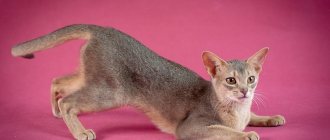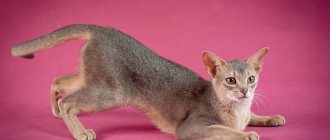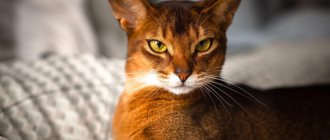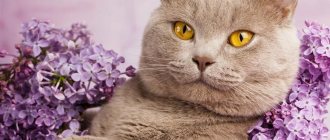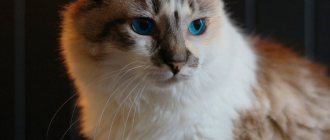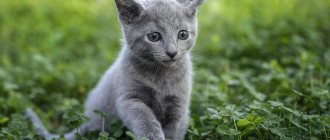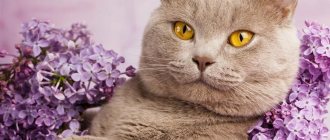The Sorrel is the most noticeable and unique color of all cat breeds. It is unique to the Abyssinian cat breed and is incredibly attractive. The animal's brick-red coat is quite rare; many breeders specifically try to obtain this unusual shade of fur in the litter.
General information
Within the Abyssinian breed, four color options are considered universally accepted, which can be divided into two groups: saturated and lightened. All these colors have a warm undertone.
| Saturated | Lightened |
| Wild (Ruddy) | Blue |
| Sorrel | Fawn |
In addition, some felinological organizations have adopted such options as chocolate, lilac, cream, tortoiseshell, as well as their silvery, “cold” variations, but they are quite rare.
What is unusual about the main Abyssinian colors? All of them belong to the group of patterned, or so-called tabby colors. But instead of the usual stripes, due to the agouti A gene, the color of Abyssinian cats is manifested by zonal coloring of the hairs, which is called ticking. That is, each hair has alternating light and dark areas - as a rule, there is a light area near the skin, then a dark one, then a light one, and finally a dark tip.
Due to such an interesting distribution of pigment, the Abyssinian cat’s fur looks as if it were powdered. When the cat is in motion, the ticking plays effectively in the light and shimmers with all its shades. The Abyssinian breed standard requires double or triple ticking, but the latter is extremely rare.
What else is unique about the Abyssinian color? Because genetically all Abyssinians are not red at all, but black! It is the black pigment eumelanin that is responsible for all this Abyssinian splendor. Depending on the set of genes and how the pigment molecules are distributed, the color turns out to be saturated or lightened. Let's look at each of them separately.
Breed standards
The main set of features consistent with the standard is given in the table.
Table 1. Abyssinian breed standards
| Part of the body | Standard |
| Head | The shape resembles a blade that turns into a graceful and elongated neck |
| Ears | Wide and deep, have ends of a darker shade. Sometimes there are tassels |
| Eyes | Almond-shaped, distinguished by dark rims that surround “glasses” of a more delicate color |
| Chin | Neat and not beveled. An exception is made for adult cats with a protruding chin. |
| Frame | Flexible and flexible, with well-developed musculature |
| Paws | Oval and compact. Five toes on the front paws and four on the hind paws |
| Tail | Tapering towards the end and thickening towards the base |
Over the last century, the Abyssinian cat has decreased in size, maintaining all proportions
Possible deviations
Abyssinian cats may have deviations from generally accepted standards, which are called faults. A list of these deviations is given below.
Table 2. Deviations from the Abyssinian breed standards
| Localization | Deviation |
| Forelegs | Availability of stripes |
| Neck | The necklace around the neck is torn in one or more places |
| Undercoat | Too light shade; does not have enough gray color |
| Eyelids | There is no characteristic edging |
| Body | Too few ticking stripes; presence of ghost ticking pattern |
Abyssinian kittens of wild color - a charming savage
Photo of an Abyssinian kitten from the Abysphere nursery.
This is the most common color option among Abyssinians; the word ruddy is translated from English as “ruddy.” Wild Abyssinian kittens have a brown-ocher undertone combined with black or dark brown ticking. A contrasting dark line runs along the back, ending at the tip of the tail, which has the most intense color. The nose is terracotta colored and has a dark edging, and the paw pads are ticked in color.
Features of the color of Abyssinians
The Abyssinian cat has beautiful, shiny fur that lies close to the body. A distinctive feature of the breed is the alternation of dark and light areas on the fur. This amazing coat pattern is called ticking and is due to the dominant agouti gene.
Uniform coloring of the guard hairs and undercoat leads to the fact that a clear pattern is not formed on the body. The breed standard does not allow stripes and rosettes, light areas on a dark background. The exception is the white chin of some representatives of the breed. This type of undercoat is welcome - rich color at the tips and muted at the base. This type is called wildcat.
The first attempts at crossing led to the appearance of long-haired and unevenly colored offspring. Modern breeders suggest that as a result of such a merger, individuals without ticking were born, which were subsequently not registered.
Abyssinian sorrel kitten – red gold
Photo of Abyssinian kittens from the Zephyr nursery
Until 1979, it was mistakenly believed that red pigment was responsible for this color, so it was called red. Indeed, the Abyssinian Sorrel kitten visually appears copper-red. But when its true nature became clear, this color was renamed Sorrel - trans. from English "bay".
At its core, Sorrel is a light brown color, also called cinnamon, with dark chocolate ticking. As with the wild color, there is a dark stripe along the back, and the most intense color is at the tip of the tail. The nose and paw pads are pink.
Character and behavior
The Abyssinian cat has an exotic appearance and character, which is distinguished by the behavior of an animal with unique wild habits. In many ways, their character and behavior have both pros and cons.
Abyssinians have the following positive traits:
- despite their exotic and arrogant appearance, Abi cats are kind, affectionate animals;
- play well with small children and do not release their claws during communication, are patient with the pranks of children and are friendly with other animals in the house;
- they easily get used to the established rules in the house, they know from childhood what a tray and a scratching post are, and that they should not spoil furniture and carpets;
- intelligent, inquisitive animals and, with persistence, amenable to training;
- they are distinguished by their cleanliness and, due to their short coat, shed relatively little, only in spring and autumn;
- have good health in the absence of genetic abnormalities.
Relatively negative character traits of the Abyssinians can be considered:
- the incredible activity of the cat, it creates an abundance of noise in the house;
- they can be timid; loud noises can cause them to jump up sharply and scare members of the household;
- having played too much, they do not feel obstacles, they are capable of not only breaking something, but also injuring themselves, even to the point of breaking bones;
- often pets are located on the windowsill and can fall out of the window;
- Abi's pets cannot stand loneliness, they always suffer and, in retaliation, begin to mischief, creating trouble for the owners in the house;
- Abyssinian cats are talkative and can make shrill sounds from the very morning, which is especially annoying when they scream heartbreakingly during estrus.
Abyssinian cat video
Blue Abyssinian kitten - mountain lion
Photo of an Abyssinian kitten from the Incendie Etoile cattery.
The soft blue color in the case of the Abyssinian breed is a lightened version of the wild color. The blue Abyssinian kitten is incredibly beautiful - the lower part of the body is colored pinkish-fawn, and the upper part is gray-blue. The dark stripe on the back is a deeper shade of blue. The nose is the color of a dusty rose, and the pads of the paws are purple, with a bluish edging between the toes.
Abyssinian blue cat - interesting facts, care and maintenance
The Abyssinian cat is a regal, graceful beauty with lined, almond-shaped eyes. Although Abyssinians are aware of their own exclusivity, narcissism is not characteristic of them. Their flexible, friendly character and easy-going nature make them wonderful companions and everyone’s favorites. Cats delight even the most inveterate dog lovers and delight the eye with delightful colors: sorrel, wild, blue and fawn. In this article we will talk about the unique blue color and its genetics, we will talk about the character traits of the Abyssinian cat and the conditions of its keeping.
Color fawn - fawn without spots
Photo of an Abyssinian kitten from the Boogie-Woogie nursery.
This rarest and youngest color of the Abyssinian, recognized in 1989, is genetically a very lightened sorrel. The apricot-beige undertone is combined with a ticking of a slightly more intense color, visually appearing almost solid. The nose and paws are light pink or salmon color.
To get a kitten with fawn color, one of the parents must have fawn color, and the other must be a carrier of the recessive gene responsible for this rare color. Another difficulty in obtaining this color is that in the litter of an Abyssinian cat, male kittens are born three times more often than female ones, and finding a female “fawn” is not an easy task.
What colors do Abyssinian cats have?
Today, Abyssinian cats are considered one of the most expensive breeds. To some extent, this is due to a beautiful “fur coat” with a beautiful color. The most common animals in the world with this coat color are:
- classic wild;
- sorrel;
- blue;
- faun;
- brown;
- lilac;
- tortoiseshell;
- silver.
Among all other colors, wild is the most popular
Thanks to uniform ticking throughout, these cats have a kind of “calling card” - each hair along its entire length is colored in different (light and dark) shades.
Classic wild color
The wild classic color is the fundamental color of the “fur coat” of representatives of this breed.
Interesting! Until 1963, this color was the only one that the relevant organizations approved as the standard for Abyssinian cats.
For a long time, only the wild color of the Abyssinians was recognized
The classic wild color is characterized by the following features:
- Presence of uniform ticking throughout all parts of the body.
- The body is distinguished by a more saturated orange-brown color.
- On the inside of the paws, as well as on the tummy, the fur is colored buffy.
- There is black feathering on both the front and hind legs. In many animals it even transfers to the pads.
- Along the entire ridge line there is a fairly wide black stripe, which smoothly ends at the very tip of the tail;
- The brick-colored nose is outlined along the edges with a darker edging.
- Abyssinians can have eyes of different colors: green, hazel or golden. However, it is worth noting that all kittens are light blue until about ten months of age.
Wild color is also the most commercial
Today, wild color is the most common among Abyssinian cats. In addition, many cats have this coloring at the genetic level.
Sorrel color
The color sorrel (red) is a lightened tone of the classic color. This shade was officially recognized for the Abyssinian breed in 1963, but until the late 70s it was most often called red.
The sorrel color involves a smooth transition of several warm shades into each other.
Animals that have this color attract attention because the color of their coat is a mixture of several rich shades: reddish, copper, bright apricot, and chocolate brown.
The characteristic features of sorrel include the following:
- Most pets have coats that are bright copper in color.
- There are two types of ticking: both dark chocolate and cinnamon shade.
- The inner side of the limbs and the abdominal area are covered with the lightest hair.
- A red-brown stripe runs along the spine, which is much darker than the dominant shade of the coat. The color of the tail is rich brown.
- There are beige-pink pads on the paws, and light chocolate flesh is visible between them.
- The nose has a pink tint. It is edged with a dark red rim.
- The most common eye colors among representatives of the breed are copper and gold. However, some Sorrel-colored pets have greenish or light brown eyes.
Sorrel is the calling card of the Abyssinian, not found in other breeds
Interesting! Sorrel-colored wool is very rarely found in representatives of other breeds. At the same time, according to standards, the Abyssinian coat should not contain black hairs.
Blue color
Organizations have officially approved the blue color for Abyssinian cats. Such animals differ from others by having a “fur coat” of a delicate and very impressive color.
The following standards are established for these animals:
- On the head, back, and head there is a characteristic pattern resembling a tailcoat, which has a beautiful bluish-gray color.
- On the chin, the inside of the limbs, in the abdomen and chest, the color of the coat is lighter - fawn, beige, pale brown, cream or apricot.
- The undercoat is a lighter shade than the main color.
- Ticking is present throughout the body and has the characteristic shade of an overcast sky.
- A fairly thin stripe runs along the entire spine, which stands out against the background of the ticking in a brighter blue color.
- The nose of these animals is either brown or gray-blue, but always has a dark edging.
- Pale pink paw pads are covered with sparse bluish hair.
- Eyes with a blue color are often golden and copper, but cats with green and hazel are often found. At the same time, many people pay attention to their special expressiveness and unique beauty.
The blue color received the green light from the exhibition managers not so long ago
Important! According to the standard, Abyssinian cats with blue fur should not have bleached undercoat.
Fawn color
The unique color fawn (translated as “fawn”) was approved in 1989. Today, this color is considered the rarest and most modern coat color. In essence, it is a shade of sorrel, but lighter.
Fawn - the lightest and softest of all colors
Important! Faun is not as common as the above variants. However, it is highly valued by many breeders. Pets have such an exquisite “fur coat” that they resemble little lionesses, attracting attention with their special sophistication.
Characteristics:
- The fur on the body is a coffee or cocoa-with-milk color.
- A stripe with a darker beige-pink color runs along the spine.
- At the tip of the tail the fur is a rich pink-beige color.
- The guard bones, like the undercoat, are colored cream or pale sand.
- Throughout the body there is ticking of a combined color: cream with lilac-beige.
- In the tummy area and on the inner surface of all legs near the body, the fur has a specific oat color.
- Pink nose with reddish edging.
- The paw pads are covered with sparse beige-pink fur.
- Different eye colors: copper, golden, greenish, dark hazel.
To participate in exhibitions, Abyssinian fawn cats must not have a bleached undercoat.
Despite its prevalence, the faun is still awaiting recognition
It should be noted that representatives of this breed can have other colors: brown, tortoiseshell, lilac or silver. However, despite the fact that recently they are found quite often, they are not considered to be generally recognized coat colors.
What about eye color?
Abyssinian kittens are born blue-eyed, like most cats of other breeds, the main color is formed by three months of age. Some breeders believe that the longer the eye color fades, the brighter the final color will be.
Photos of Abyssinian kittens from the Abysphere nursery
All Abyssinian colors are characterized by yellow-orange eye color, which harmonizes perfectly with all four colors. The more expressive and brighter the eye color, the higher the cat will be rated. There is also a yellow-green eye color called hazel. But the rich green tint of the iris is very rare for Abyssinians.
Photos of Blue Abyssinians
Possible deviations
- narrow or rounded skull;
- stripes on legs;
- drawing on the body;
- prominent cheekbones;
- light undercoat;
- fuzzy ticking;
- round eyes;
- small ears;
- flabby muscles;
- short legs and tail;
- lack of dark eyeliner around the eyelids;
- light areas on the coat;
- pointed muzzle;
- "fox" look.
What is considered a fault in the color of Abyssinian kittens?
Like the color of the eyes, the shade of the Abyssinian coat gains color over time, and after the first baby molt it looks a little different - more rich and perfect. Since color is the main breed-forming characteristic of Abyssinians, when choosing a kitten you should pay attention to the quality of color, especially if you are planning a show career for your pet or participation in breeding. Among the disadvantages are the following:
- stripes and spots on the paws, tail and chest;
- grayish or earthy undertone or light undercoat;
- open necklace (ring-shaped design on the neck);
- ticking defects (for example, reverse ticking, when the tip of the hair is not dark, as expected, but light).
Cats with color deficiencies can be used for breeding, but obtaining high titles at exhibitions for such an animal becomes impossible. Much more serious color defects can lead to complete disqualification of the animal, and also indicate that they are trying to sell you a mestizo under the guise of a purebred animal. Be wary if your kitten:
- closed necklace;
- white spots, such as a medallion or a white neck - within the breed, only white chin and area near the nostrils are allowed;
- brown shade of fur;
- bright stripes on the belly, paws, and tail are unacceptable within the Abyssinian breed.
The highest quality of color is highly valued by breeders, ardent fans of the breed and expert felinologists - of course, an animal of this class will have an appropriate price. If you want to buy an Abyssinian kitten as a pet, then you can turn a blind eye to minor color flaws and even save a lot of money, since pet class kittens without breeding rights are much cheaper than future stars of cat shows.
We advise you to purchase Abyssinian kittens from trusted nurseries, regardless of the color you choose, because only a nursery can give you guarantees of breed origin and good health.
How to care for Abyssinian cats?
If you properly care for an Abyssinian, he can live for about twenty years. However, some animals exhibit genetic pathologies such as polycystic kidney disease, atrophic retinopathy of the eye, and blood diseases caused by the destruction of red blood cells. In addition, cats often suffer from gingivitis and leukemia.
Abyssinian cats can safely be called long-livers
To prevent the development of many diseases and all kinds of complications, the following rules must be followed:
- Maintaining a proper diet.
- Brush your teeth twice a month.
- Brush the coat once a week with a special brush to remove dead hair.
- Trim nails as needed.
- Get checked by a veterinarian.
- Get vaccinated.
Video - Characteristics of the breed and methods of care
What to feed Abyssinian cats?
To maintain the health of pets and a beautiful “fur coat,” it is important that they have a nutritious diet. It can be either natural or industrial.
Representatives of the breed will not refuse fruit either.
It is better to prepare a diet of natural products together with a veterinarian so that the cat receives all the vital vitamins and minerals along with food. To do this, the animal should be given the following products:
- Boiled meat (preferably lamb and beef) and poultry.
- Sea fish.
- Boiled vegetables in chopped form.
- Dairy products.
- Eggs.
- It is recommended to add a little flaxseed or olive oil to your food.
- Vitamin complexes.
Among dry food, give preference to the premium segment
Many owners of Abyssinian cats prefer industrial food. However, you should only use extra-premium dry and wet food, as well as holistic food, which is based only on natural ingredients. If there is intolerance to certain food ingredients, the Abyssinian cat may develop an allergy. Read more about its symptoms and treatment on our portal.
We will look in more detail below at the foods that under no circumstances should be given to an Abyssinian cat.
Dangerous foods for the Abyssinian cat
Care and maintenance
Abyssinian cats are easy to care for. They are undemanding and unpretentious in food, but special attention will have to be paid to their health. It is important to maintain the vitality of animals at the proper level.
Kittens are a little shy, so on the first day in a new home, pay attention to the baby, be affectionate, and introduce him to other pets and family members. Do not overload the kitten with games, give time to get used to the new environment.
Abyssinian cats prefer to explore the territory on their own. The owner’s role in this matter is not to interfere, to provide a comfortable place to sleep, to provide a house, a tray, bowls for water and food, and a scratching post.
Hygiene
Abyssinian kittens are easily litter trained. Breeders advise choosing a tray based on the size of the pet. When choosing a filler, pay attention to silica gel or clumping. The woody one holds the smell well, but sticks to the paws and scatters on the floor, which causes a lot of trouble for the owners.
It is better to start cutting nails and water treatments from an early age in order to avoid problems with hygiene in the future. Bath days are rarely arranged - once during a period of intense molting is enough. Shampoos for short-haired cats without fragrances are used for washing. After bathing, the fur is blotted with a terry towel and the cat is released to dry.
